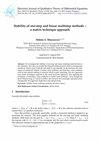Nonconstant positive steady states and pattern formation of a diffusive epidemic model
IF 0.8
4区 数学
Q1 MATHEMATICS
Electronic Journal of Qualitative Theory of Differential Equations
Pub Date : 2022-01-01
DOI:10.14232/ejqtde.2022.1.20
引用次数: 0
Abstract
It is our purpose in this paper to make a detailed description for the structure of the set of the nonconstant steady states for the two-dimensional epidemic S-I model with diffusion incorporating demographic and epidemiological processes with zero-flux boundary conditions. We first study the conditions of diffusion-driven instability occurrence, which induces spatial inhomogeneous patterns. The results will extend to the derivative of prey's functional response with prey is positive. Moreover, we establish the local and global structure of nonconstant positive steady state solutions. A priori estimates for steady state solutions will play a key role in the proof. Our results indicate that the diffusion has a great influence on the spread of the epidemic and extend well the finding of spatiotemporal dynamics in the epidemic model.扩散流行病模型的非常正稳态和模式形成
本文的目的是详细描述包含人口和流行病学过程的二维流行病S-I模型在零通量边界条件下的非恒定稳态集的结构。我们首先研究了扩散驱动的不稳定发生的条件,它引起空间非均匀模式。结果将推广到猎物的功能反应导数与猎物是正的。此外,我们建立了非常正稳态解的局部和全局结构。对稳态解的先验估计将在证明中起关键作用。我们的研究结果表明,扩散对流行病的传播有很大的影响,并且很好地扩展了流行病模型中的时空动力学发现。
本文章由计算机程序翻译,如有差异,请以英文原文为准。
求助全文
约1分钟内获得全文
求助全文
来源期刊
CiteScore
1.40
自引率
9.10%
发文量
23
审稿时长
3 months
期刊介绍:
The Electronic Journal of Qualitative Theory of Differential Equations (EJQTDE) is a completely open access journal dedicated to bringing you high quality papers on the qualitative theory of differential equations. Papers appearing in EJQTDE are available in PDF format that can be previewed, or downloaded to your computer. The EJQTDE is covered by the Mathematical Reviews, Zentralblatt and Scopus. It is also selected for coverage in Thomson Reuters products and custom information services, which means that its content is indexed in Science Citation Index, Current Contents and Journal Citation Reports. Our journal has an impact factor of 1.827, and the International Standard Serial Number HU ISSN 1417-3875.
All topics related to the qualitative theory (stability, periodicity, boundedness, etc.) of differential equations (ODE''s, PDE''s, integral equations, functional differential equations, etc.) and their applications will be considered for publication. Research articles are refereed under the same standards as those used by any journal covered by the Mathematical Reviews or the Zentralblatt (blind peer review). Long papers and proceedings of conferences are accepted as monographs at the discretion of the editors.

 求助内容:
求助内容: 应助结果提醒方式:
应助结果提醒方式:


